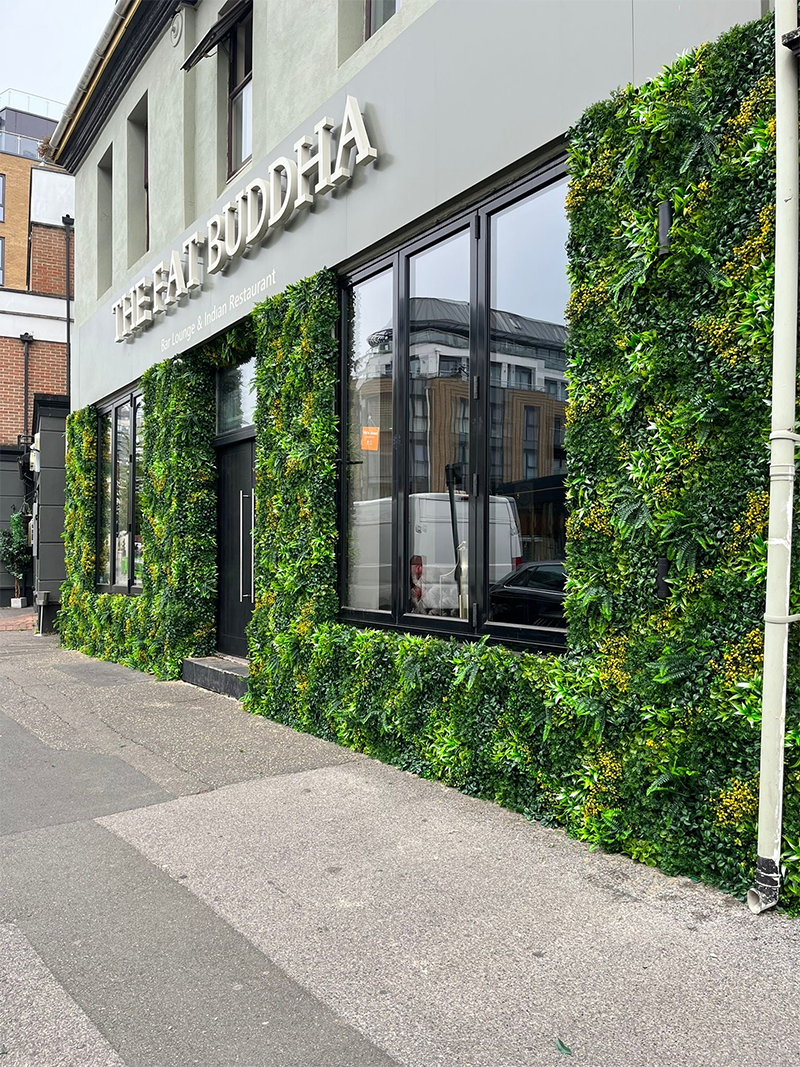Determining Planting Density for 3D Artificial Vertical Gardens: Balancing Visual Impact, Airflow, and Structural Integrity
The planting density of a 3D artificial vertical garden significantly influences its aesthetic appeal, maintenance requirements, and long-term durability. Unlike real plants, artificial varieties do not compete for nutrients or light, but their arrangement must still account for airflow, weight distribution, and visual harmony. A well-planned density ensures the garden looks lush without appearing overcrowded, while also preventing issues like moisture retention or structural strain. Below are key factors to consider when establishing the ideal planting density for artificial vertical gardens.

Achieving a natural, vibrant look requires careful attention to how artificial plants fill the available space. The density should create depth and texture while avoiding a sparse or cluttered appearance.
Foreground, Midground, and Background Layering: Divide the garden into distinct visual zones by placing larger, bolder artificial plants in the foreground or as focal points, medium-sized varieties in the midground for volume, and smaller, finer designs in the background to add subtlety. This tiered approach creates a sense of dimension, even in flat walls, and ensures no single area feels empty or overcrowded.
Negative Space Utilization: Intentionally leaving gaps between certain artificial plants can enhance the garden’s visual rhythm. These empty spaces allow the eye to rest, highlight key plants, and prevent the design from feeling monotonous. For example, spacing out trailing vines or spiky succulents can create dynamic contrast against denser clusters of ferns or broad-leaved varieties.
Color and Texture Distribution: Varying the density of plants based on their color and texture adds complexity to the garden. Place darker, more saturated artificial plants in smaller quantities to avoid overwhelming the design, while using lighter or more neutral tones in larger groups to create a balanced backdrop. Mixing matte and glossy finishes can also add visual interest without relying on real foliage variation.
Although artificial plants do not require watering, the growing medium or container may still accumulate humidity, especially in enclosed or poorly ventilated spaces. Proper spacing ensures adequate airflow, reducing the risk of mold or mildew.
Minimum Spacing for Ventilation: Leave at least 1–2 inches between artificial plants to allow air to circulate freely. This gap is particularly important in high-humidity environments, such as bathrooms or covered patios, where condensation may form. Wider spacing may be necessary for gardens installed near heating or cooling vents to prevent moisture buildup.
Drainage Considerations for Container-Based Gardens: If the artificial garden uses a growing medium for anchoring plants, ensure there is enough space between plants for water to drain away from the base. Overcrowding can trap moisture against container walls, leading to corrosion or material degradation over time.
Preventing Dust Accumulation: Dense arrangements can trap dust, making the garden harder to clean. Spacing plants slightly apart allows for easier access with a duster or vacuum attachment, maintaining a fresh appearance with minimal effort.
The combined weight of artificial plants, containers, and growing medium must not exceed the structural capacity of the mounting surface. Proper density planning ensures the garden remains securely attached without causing damage.
Weight Calculation per Square Foot: Estimate the total weight of the garden by adding the weight of the artificial plants, containers, and medium, then divide by the total area to determine the load per square foot. For lightweight walls or partitions, aim for a lower density to minimize stress. Heavier materials, such as metal-framed containers or dense aggregates, may require wider spacing to reduce overall weight.
Balancing Front-Heavy Designs: Artificial plants with large, broad leaves or heavy bases can create a front-heavy effect, increasing the risk of detachment. Distribute these heavier plants evenly across the garden or pair them with lighter varieties to maintain balance. For cascading designs, ensure trailing plants are anchored securely to prevent sagging.
Adjusting for Wind Exposure: Outdoor gardens exposed to wind may require a lower planting density to reduce wind resistance. Sparse arrangements allow air to pass through more easily, preventing the garden from acting like a sail and pulling away from the wall. In sheltered areas, a denser design may be feasible without compromising stability.
The density of the garden should not hinder routine maintenance, such as cleaning, repairing, or updating the design. Easy access to individual plants ensures the garden remains in good condition over time.
Spacing for Tool Access: Leave enough room between plants to use cleaning tools, such as brushes or compressed air canisters, without damaging nearby foliage. This is especially important for gardens installed at height, where reaching tight spaces may be challenging.
Flexibility for Future Modifications: A slightly less dense garden allows for easier rearrangement or replacement of artificial plants as design trends evolve or individual pieces wear out. Modular containers or interlocking plants can further enhance adaptability, enabling sections of the garden to be updated without dismantling the entire installation.
Zoning for High-Traffic Areas: In spaces where the garden is likely to be touched or brushed against, such as near doorways or seating areas, use a lower density to prevent accidental damage. Sparser arrangements also reduce the risk of artificial plants becoming dislodged by frequent contact.
By considering visual fullness, airflow, structural load, and maintenance accessibility, the planting density of a 3D artificial vertical garden can be optimized for both beauty and functionality. This approach ensures the garden remains a striking, low-maintenance feature that enhances any indoor or outdoor space.
Contact: Amy
Phone: 86-15311787313
E-mail: info@foszmac.com
Whatsapp:86-15311787313
Add: Fengtai District, Dacheng Road, No.24 Building, Room 203, Beijing, China